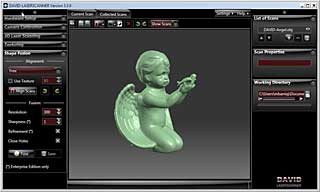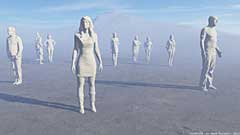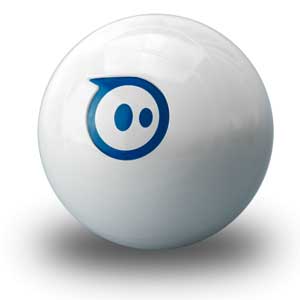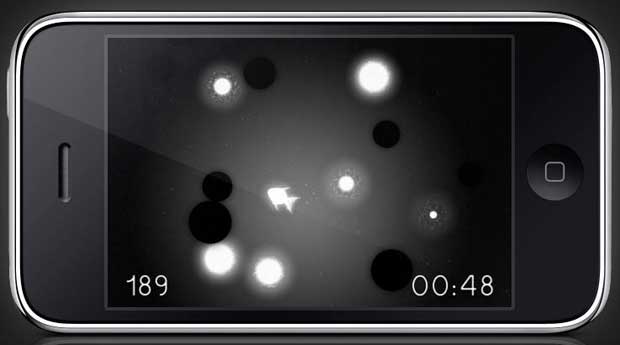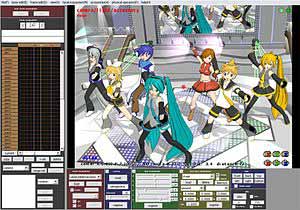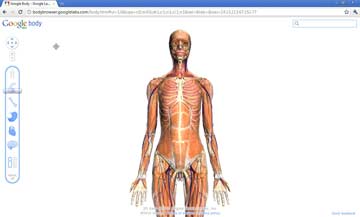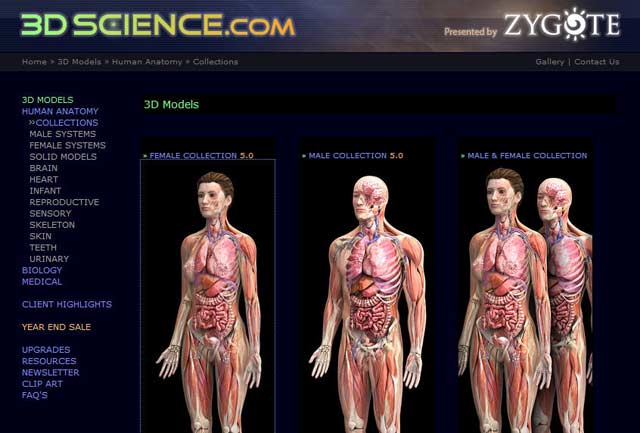Flash 10 (Adobe Flash CS4 Professional) was released on october 14, 2008, has a native support of 3D and uses pixel blender for lighting. Adobe Pixel Bender technology delivers a common image and video processing infrastructure which provides automatic runtime optimization on heterogeneous hardware. You can use the Pixel Bender kernel language to implement image processing algorithms in a hardware-independent manner. The Pixel Bender graph language is an XML-based language for combining individual pixel-processing operations (kernels) into more complex Pixel Bender filters.
The following 3D engines for Flash are based on the native Flash 3d API :
CopperCube
CopperCube is a 3D engine / editor with deployment targets for Flash (.swf) and Windows (.exe). You can create simple interactive 3D scenes without the need to write one single line of code or even create whole games with the help of a little bit of scripting magic. CopperCube supports realtime 3D character animation, also known as skeletal animation. It supports playing back animated meshes with an unlimited amount of joints and an unlimted amount of weights. Milkshape (.ms3d) is a recommended 3D software to import meshes and animations in CopperCube. Version 1.1.3 of CopperCube was released on january 14, 2010.
CopperCube is a product of the austrian company Ambiera e.U., located in Vienna and owned by Nikolaus Gebhardt. The price for a Light Edition license is 99 €, the Per-seat license for the professionbal version costs 295 €. A 30 days trial version is available for free.
Away3D
Away3D is a realtime 3D engine for flash in actionscript 3, originally derived from Papervision3D. Away3D engine is designed to be fast and extensible. Away3d is an open source production, and relies on the talent and support of industry professionals to keep itself moving. Version 3.4 for Flash 10 was released on august 7th, 2009. The founders of Away3D are Rob Bateman (lead developer) and Alexander Zadorozhny (core developer). The Away3D Team includes about 12 other developers.
An Away3D Lite version is also available. Currently weighing in at under 25K, Away3D Lite can be used in projects with the most stringent bandwidth restrictions. No problem for use in banners, widgets, thumbnails… anything where filesize is a priority. But the biggest single feature offered by the new engine is it’s speed. Current tests clock framerates up to 4 times faster than the standard Away3D library. And with more frames-per-second comes the potential for more polygons, more accessible content on slower machines, and more processing power left for other areas of a Flash application.
Some outstanding examples of Away3D projects are “Café World” on Facebook used by 23 Million people a month, Multipass latern, Shaded Head, Spitfire , Dragonfly and Normalmaps.
PapervisionX
PapervisionX is the next version of Papervision3D built from the ground up based on Flash10’s new 3D api. Ralph Hauwert and Tim were leading the initial efforts on the core of the engine. Papervision3D (pv3D) is an open source 3D engine for the Flash platform. It is written and maintained by a small core team, and contributed to by its ever-growing community. Papervision3D is distributed under the MIT license and is hosted by Google Code.
3D Pixel Engine
Freelancer Kris Temmerman, owner of the Neuro Productions company, is the creator of the 3d Pixel Engine. Instead of rendering each cube every frame in an isometric perspective, he renders only one cube and use that cube as a particle to render a full scene. This way he easily extends the limit of +-1000 cubes to 20.000 or more cubes in a Flash scene.
Kris Temmerman was motivated by the cool 3D pixel editor Q-BLOCK created by Okuyama Kazuya. He developed not only the 3D engine, but he made also a Collada parser witch converts a standard 3D mesh to a 3D pixel object to import external generated 3D objects. Some of Kris Temmermans experiments are really outstanding : 3D Fur Renderer, Collada Parser, Z-Brush Modelling, Simple Flash Ecosystem, Pushing data to Flash using binary sockets (Java / Flash), Dynamic Flash generated favicon, Custom brushes, Panoramic fun, Alice in Wonderland, Nurbs.
Kris Temmerman is a member of the Away3D Development Team and mainly responsible for the Flash 10 upgrade.
Alternativa3D
Alternativa3D is a browser 3D-engine based on Adobe Flash and allows to show three-dimentional worlds, games, virtual tours or objects in a browser. Alternativa3D is provided as SWC-library, which is availiable for all registered AlternativaPlatform users.
Alternativa3D is free for non-commercial purpose with condition to provide a link to AlternativaPlatform. A basic standard licence costs 1000 Euro for one commercial project. The current version is 5.6.0. The Alternativa platform is developed by Alternativa Game, Ltd. in Russia, the team counts currently 15 people.
Infinity3D
The multi-tasking Infinity3D engine for flash (as3) was designed by Alexei Mikhailovich Romanov from Petersburg. The latest version 1.4.D was released on september 17, 2009. The engine supports animated dynamic objects.
Yogurt3D (Y3D)
Yogurt 3d Engine Corp. announced in december 2009 that there free Adobe Flash 3D Engine API will be ready and available to download for everyone soon. Scene management, character animation and multiple scene support are some of the features included in the Yogurt3D Game Engine.
FIVe3D
The FIVe3D initiative is an open source code for the conception of interactive vector-based 3D animations. The original Actionscript 2 code was ported to Actionscript 3 for Flash 10. The project is developed by Mathieu Badimon.
Like Papervision3D, the following 3D Flash engines are not yet based on the Flash 10 3D API, but nevertheless very performant:
Sophie 3D
Sophie 3D enables you to view models online with the Flash Player. To do this the model needs to be saved in Wavefront OBJ format. Sophie3D gives you high quality fast renders by displaying over 80.000 polygons in realtime with textures, reflections, transparency and infinite number of lights.
Sophie 3D is one of the products developed at XOSystem. Sophie 3D Component is free to download and use on the condition that it is not used for commercial purposes and that the logo “Sophie 3D Engine” and all the other graphic elements are in no way hidden or modified.
Sophie 3D Component PRO for Adobe Flash Player has the retail price of 239,00 euro. The Sophie 3D Player Pro Licence is for a single domain use only and allows to publish 3D models without the logo appearing on a 3D scene. It includes Sophie 3D Compressor that can reduce the size of a Wavefront .obj models by about 75%. For example a model file of 1Mb will be compacted to a file of 250Kb.
Sandy 3D
Sandy 3D is an intuitive and user-friendly 3D open-source library developed now in Actionscript 3.0 for Adobe Flash. Sandy can be used in a commercial project. Sandy3.0 is able to render about 2000-5000 polygons correctly on a pretty recent computer with really correct screen resolution. Version AS3 3.1.2 was released on 28th March 2009.
FFilmation
The FFilmation Engine is an AS3 isometric programing engine, focused mainly on game development. The aim of the project is providing a robust development platform, where game designers can work on the game’s details and forget about the render engine. It is intended to be really usable from a “real production scenario” point of view. The engine is open-source, and released under the MIT license.
FFilmation is developed by Jordi Ministral, the co-owner of a small multimedia production studio in Barcelona, Spain. Version 1.3.3. was released on march 13, 2009. A FFilmation editor is also available. In september 2009, the developer announced on his blog that FFilmation is progressing quietly.
The following Flash 3D projects are listed mainly for historical reasons :
WireEngine3D (we3d)
WireEngine3D is a lightweight and fast 3D Engine for Flash 8/9. The latest version: 3.5.1 was released on 9th april 2008. With the WireEngine it is very easy to animate 3D objects in the 3D world.
3D Engine for Flash MX2004
The OpenSource 3D Engine for Flash MX 2004 allows to create 3D applications using the builtin DataCube object and put data as dynamic 3D Models into a virtual universe.
3DFS
3DFS is a 3D engine written in ActionScript 2 compatible with Flash Player 7.0 or more. It offers exact visible surface determination even for intersecting or overlapping geometry.
Electric 3D
The Electric 3D Flash engine is used internally by Electric Oyster, an interactive design, development and consulting company, when they develop 3D projects for their clients.
Jiglibflash now also supports Five3D
